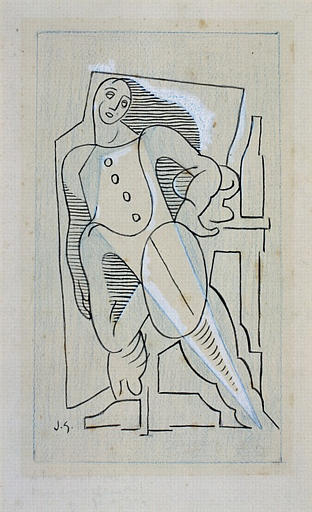Description
Juan Gris's work "Harlequin", created in 1920, is a fascinating testament to the evolution of Cubism and the artist's personal style. Juan Gris is a central figure in Cubism, known for his ability to combine the formal analysis of structure with a rich sense of color and emotion. In this painting, the harlequin, a traditional character of Italian comedy, is recreated through a pictorial language that challenges the norms of representation and provokes reflection on art itself.
The composition of “Harlequin” displays an intricate intersection of planes and perspectives. The harlequin appears at the centre of the image, divided into facets that evoke the geometric form characteristic of Cubism. This formal choice suggests the complexity of the character’s identity, which, like the technique, is composed of multiple layers and meanings. The use of decorative elements, such as the rhombuses found on the harlequin’s costume, reinforces the connection between the figure and the tradition of the theatre, while the fragmentation of the form suggests a dialogue with the realm of modern art.
The color in “Harlequin” is subtle yet striking. Gris uses a palette dominated by earthy tones, which are balanced with hints of blue and red. This color combination brings a vibrant quality to the painting, while maintaining a balance that is characteristic of the artist’s work. The color choice not only brings the harlequin to life, but simultaneously provokes the viewer to reflect on the tension between joy and melancholy that the character embodies. The play of light and shadow, together with these hues, create a sense of depth that gives the work a unique three-dimensionality.
It is also remarkable how Juan Gris plays with space and form. The harlequin's anatomy, though stylized and geometric, does not lose its humanity; in fact, the representation feels almost symbolic, an amalgam of essence and form that encapsulates the madness and creativity of art. While the harlequin's face is recognizable, his ethereal integration with the background and his dissolution into abstract forms reflect the tensions inherent to his character and his role in the comedy, suggesting an intersection between reality and fantasy.
The work is not only a portrait of the harlequin, but also a dialogue on the role of the artist and the complexity of representation in art. While the figure of the harlequin is emblematic in its essence of being an observer and participant in the theatre of life, its decomposition is part of a journey towards the reinvention and reconstruction of meaning. This painting is, in essence, a reflection on Gris's own creative process, which is characterized by his ability to reinterpret and challenge preconceived ideas about form and color.
Through “Harlequin,” Juan Gris not only pays homage to a figure from classical theater, but also captures the nuances of modernity in an ever-changing environment. In recoding this figure, the viewer is invited to explore the layers of meaning that art can offer, turning the viewing experience into an intimate and evocative conversation about the human being, art, and the multiple dimensions of perception. This work stands as a significant example of Cubism, showcasing Gris’ mastery in fusing technique and emotion, a legacy that resonates deeply in the art landscape of the 20th century.
KUADROS ©, a famous painting on your wall.
Hand-made oil painting reproductions, with the quality of professional artists and the distinctive seal of KUADROS ©.
Painting reproduction service with satisfaction guarantee. If you are not completely satisfied with the replica of your painting, we will refund 100% of your money.

